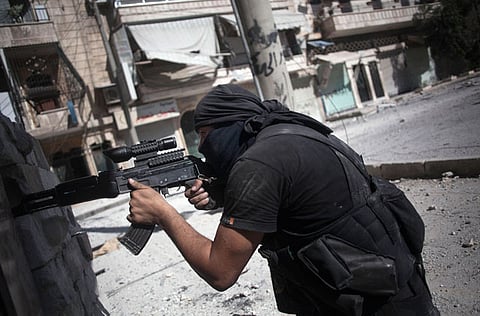Syrian regime in demolition mode
Only in Libya and Syria the army accepted being used as a tool by the dictators

It is not true at all that all Arab armies are merely private militias at the beck and call of the rulers. Some of them are real national armies and quite a few have turned out to be more nationalistic than others during the Arab Spring. Although it has been reported that the deposed Tunisian president, Zine Al Abidine Bin Ali, had ordered the army to launch air strikes against certain revolting areas in the country during the Tunisian revolution, the army commander refused to obey his orders. Instead, he called upon the president to leave the country. And when Bin Ali found out that the army was not going to put down the revolution, he had no choice but to succumb to the people’s will. He left Tunisia for Saudi Arabia. Had the army tried to quell the revolution, it would have taken much longer than four-and-a-half weeks to succeed, if at all.
Similarly, the overthrown Egyptian president, Hosni Mubarak, tried to frighten demonstrators using the army. When the going got really tough for the president, he ordered the armed forces to get down to Tahrir Square where millions of Egyptians had gathered to call for the overthrow of the regime. We saw tanks and army officers in and around the place. We also saw the then defence minister, Mohammad Hussain Tantawi, shaking hands with soldiers around the television and radio complex, calling on them to serve their country in “this trying time”.
Mubarak went even further when he ordered aircraft to fly at a low altitude over Tahrir Square in an attempt to scare demonstrators away, but to no avail. In other words, Mubarak never pushed too far. He knew full well that the Egyptian army was a real national army and not a private militia, as is the case with some Arab republics. An Egyptian commentator had remarked at the time that “the army could have fired the first shot at the people, but the second one would have certainly targeted the presidential palace”, as the army was not known to accept being used as a gang against its kith and kin. In fact, were it not for the army, as was the case in Tunisia, it would have taken the Egyptian people much longer to finish off the Mubarak regime. It has been reported that the army generals pressured the president to step down and he did.
Even in Yemen, although the army was very much controlled by Ali Abdullah Saleh and his clan, it played a nationalistic role, as some of the senior generals joined the revolution.
It was only in Libya and Syria that the army accepted being used as a tool in the hands of the dictators. Muammar Gaddafi vowed to put down the revolution with military force from the very beginning. He even threatened to wipe the city of Benghazi off the face of the earth, which made the international community later help the Libyan people get rid of Gaddafi militarily.
Likewise, the Syrian leadership has managed to use the army effectively to counter the revolution. The Syrian president ordered the armed forces to get down to the streets, four weeks after the intifada started, although, as the president himself confessed, the people did not use arms against the regime until the sixth month of the revolution. However, the Syrian leadership never dealt with the rebels as demonstrators, but simply as a “local enemy”, as the president described them. Hence, its carpet bombardment of Syrian cities and villages. It has never happened in modern history that a national army used all its land, naval and air power to quell a popular revolution so barbarically. Whole Syrian cities and villages have been flattened just to kill the armed revolutionaries fighting the army from within, which reminds one of what the Russians and the Americans did in both Grozny in Chechnya and Fallujah in Iraq.
It is quite horrifying to see the Syrian army bringing down whole neighbourhoods over the heads of its citizens just to drive out a score of “terrorists”, as the Syrian regime calls them. It usually takes a professional army of more than a hundred soldiers to overcome a single armed person hiding inside an inhabited area. But in Syria, the army does not believe in conventional military norms. Instead of targeting the rebels inside buildings, it prefers to destroy the whole building along with all its inhabitants all at once. Some lucky inhabitants would have fled their homes long before the operations and thanks to what has been known now as the “Syrian genocide”, millions of Syrians have been rendered homeless or refugees, as millions of houses have been brought down to the ground in order to vanquish the rebels. It is no wonder that a Syrian satirist has likened what the army is doing to a hunter who wants to shoot a bird standing on the head of an elephant, but instead kills the elephant and misses the little bird.
No regime in modern history has used its air force so extensively to pound populated areas. Even in Latin America, the rebels, during the 1960s and ‘70s, attacked the ruling juntas from within the cities. However, the fascist dictators never used aircraft to bomb or strafe the rebels inside the towns. Yet, the regime in Syria did just that, whereby several cities and villages have been ravaged and reduced to ashes by the army.
It seems that the Syrian regime has no problem at all destroying the house over the family simply because there is an armed rebel inside it.
Faisal Al Qasim is a Syrian journalist based in Doha.
Sign up for the Daily Briefing
Get the latest news and updates straight to your inbox


